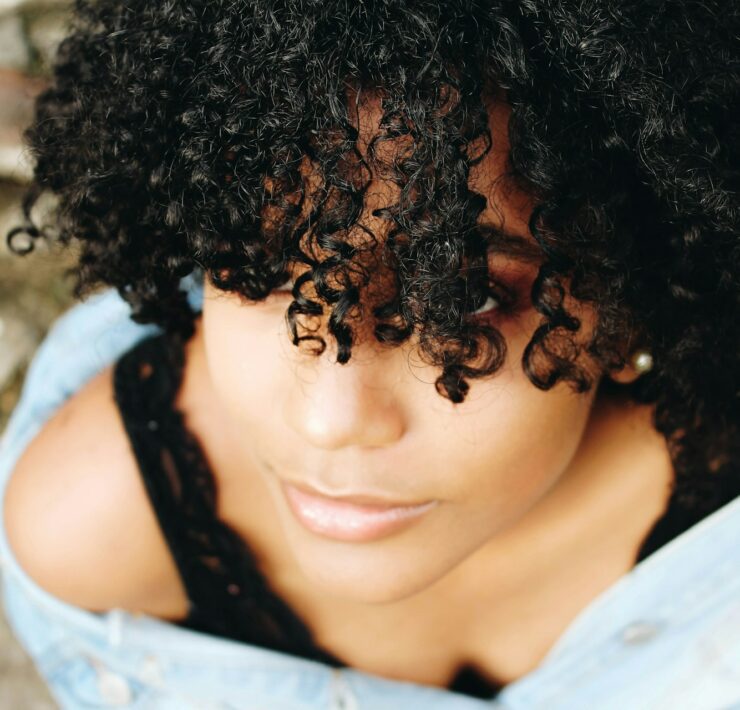
Type 4 hair is a hair type that is characterized by tight coils. It is divided into three subtypes: 4A, 4B, and 4C.
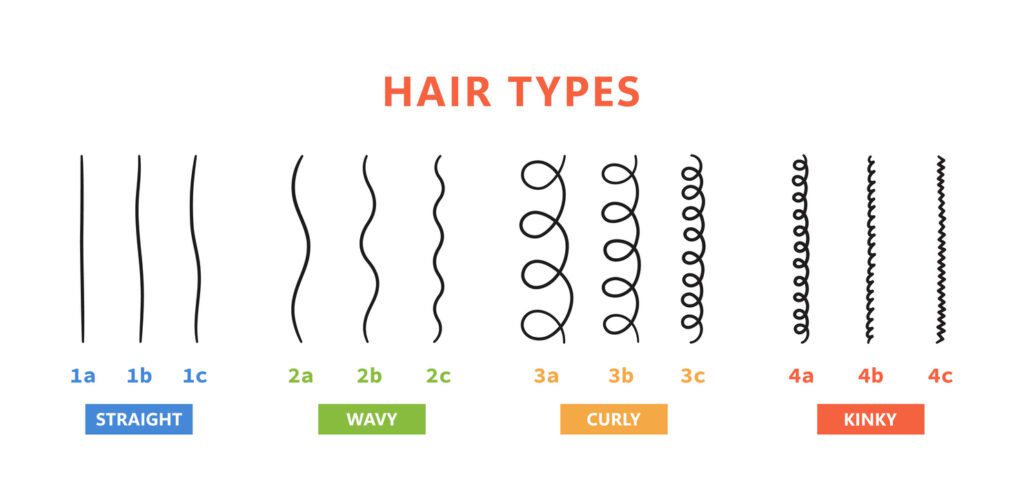
Type 4A hair has medium-sized, loosely packed curls with a springy S-shape and is about the size of a crochet needle. The coils in type 4A hair are not as interlocked as those in type 4B or 4C hair, and type 4B hair has densely packed curls tighter than type 4A hair.
The loops in type 4B hair resemble tight curls that aren’t as tight as those in type 4C hair.
Type 4C hair has tightly coiled strands that range from super fine, thin, and soft to wiry and coarse.
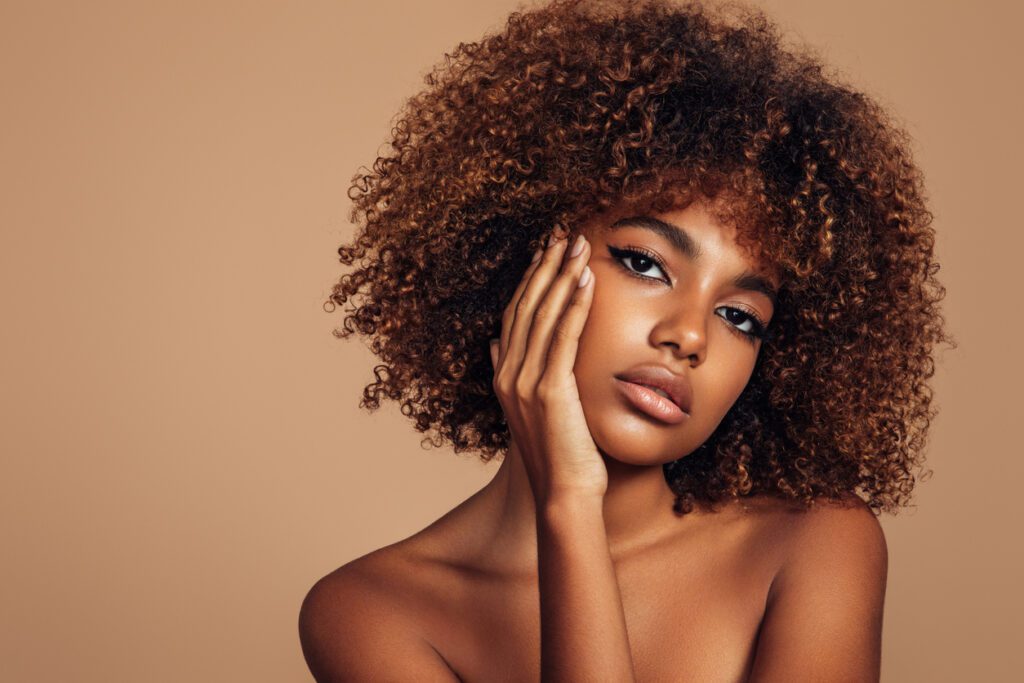


Type 4 hair may seem robust, but it’s the most fragile texture because it has the fewest cuticle layers to protect it from dryness. Its top concerns are maintaining moisture, avoiding tangles, and preventing breakage.
Type 4 hair should not frequently shampoo; instead, wash your hair once a week, depending on what works best for your coils.
It’s also essential to take care at night by putting your hair up before going to bed to avoid extreme bedhead (e.g., tangles and breakage). Additionally, using a pre-poo with coconut oil helps retain your scalp’s natural chemistry.
Subtypes of Type 4 Hair
Type 4 hair is a coily hair type that is further divided into three subcategories: type 4A, type 4B, and type 4C.
Type 4A hair has medium-sized, loosely packed curls with a springy o-pattern or s-shape about the size of a crochet needle. The coils of type 4A hair are not as interlocked as those of type 4B or 4C. Type 4B hair has densely packed curls that are tighter than those of type 4A. The coils bend in a way that makes them have a zig-zag pattern, forming tight “Z” curls vertically when gently pulled down. Type 4C hair boasts a zig-zag and random pattern, typically showing no defined curls without styling. Up close, type 4C hair has tiny, tight “o”-shaped loops. This hair can be both wiry and coarse and thus requires more regular moisture to achieve most styles.
Each subtype of type 4 hair has its unique characteristics, which require different care routines. For example, due to the distinctive ringlets of type 4A hair, it’s difficult for the scalp’s natural oils to reach down the length of the hair shaft toward the ends, and therefore, it mainly struggles with dryness. On the other hand, type 4C hair requires more regular moisture to achieve most styles because it is wiry and coarse. To care for any subtype of type 4 hair, it’s essential to establish a strict regimen that includes gentle handling, deep conditioning treatments, protective styling options like braids or twists, and using products specifically formulated for coily or kinky textures.
It’s important to note that determining one’s natural hair type can be challenging since each type has many variations. Additionally, some people may have multiple curl patterns on their heads.

Type 4A Hair
Type 4A hair has medium-sized, loosely packed curls with a springy S-shape and is about the size of a crochet needle. The coils are not as interlocked as 4B or 4C curls, and each strand independently curls or spirals away from other neighboring strands.
Type 4A curls retain moisture well and don’t shrink as much as type 4B hair.
Caring for type 4A hair requires a gentle touch and a consistent moisturizing routine. Adding moisture to 4A hair is crucial as it helps keep the hair from breaking easily and makes it more malleable.

The key to styling type 4A hair is finding products and techniques that add definition, shine, and moisture. Moisturizing often is essential since this hair type tends to be naturally dry. Deep conditioning is an essential part of maintaining healthy 4A hair. 4A hair thrives with weekly, warm deep conditioning treatments. When looking for a deep conditioner for type 4A hair, choose one with ingredients that will help moisturize and nourish the hair. Some of the best ingredients to look for in a deep conditioner include coconut oil, shea butter, soybean oil, jojoba oil, avocado oil, baobab oil, and mafura oil. These ingredients are known for their ability to deeply penetrate the hair shaft and provide intense hydration and nourishment to the hair.
The LOC method can also help seal moisture using a leave-in conditioner (L), oil (O), and cream (C), or oily cream (OC).

Type 4B Hair
Type 4B hair is coily typically densely packed with a zig-zag or Z-shaped curl pattern. It sits between type 4A and 4C curls. Type 4B hair tends to be porous, dry, and prone to breakage. People with type 4B hair might also have patches of 4A and 4C textures.
The most significant difference between type 4B hair and other hair types is the pattern of the curl, which is less defined than type 4A curls but more defined than type 4C coils.
To keep type 4B hair healthy, it needs tons of water. A cleansing conditioner free of sulfates and filled with hydrating ingredients can help. Monthly hot oil treatments can seal moisture, while leave-in conditioners can help moisturize day-to-day.
Type 4B hair has tight “Z” shaped strands with a bit of definition in curl shape. Often, it is fluffy and can be soft or coarse depending on hair texture. The main difference between Type 4B and Type 4C natural hair is the curl pattern and how tight the coils are. For example, Type 4C hair has tighter loops than Type 4B. While both types have a high level of shrinkage and require a lot of moisture, Type 4B hair is easily distinguished by its zig-zag pattern, while Type 4C tends to clump more at the ends and is more prone to shrinkage than Type 4B.

Type 4C Hair
Type 4C hair is the curliest hair type and is on the delicate side. It has tight “Z” pattern coils with about 75% shrinkage compared to the length of the hair strand. The “Z” pattern can be difficult to distinguish because the coil is tight and dense. Up close, type 4C hair has tiny, tight “o”-shaped loops. Type 4C hair is characterized by being dry, frizz-prone, and easily tangled and matted. It doesn’t retain moisture easily, making it the most dehydrated of all curly hair types. Type 4C hair is formed of fluffy strands lacking a defined curl pattern. The texture of 4C varies widely from person to person, from fine to coarse texture. It experiences so much shrinkage it can make you feel like your hair is growing very slowly or not at all.
To care for type 4C hair, focusing on moisture retention and protection is essential. Avoid frequent shampooing and heat, deep condition regularly, try the LOC/LCO method (leave-in conditioner, oil, cream), gently detangle, and protect your hair. The LOC method helps seal moisture in. At the same time, always keep your water bottle nearby. Pre-pooing before washing can help minimize tangling.
The key to styling type 4C hair is finding products and techniques that add definition, shine, and moisture. Moisturizing often is essential since this hair type tends to be naturally dry. Deep conditioning is an essential part of maintaining healthy 4C hair. 4C hair thrives with weekly deep conditioning treatments. Deep conditioners should be kept longer, between 20 minutes to an hour or more. The longer time allows the deep conditioner to penetrate the hair shaft and ensure it is thoroughly conditioned and moisturized. Once or twice a week deep conditioning is enough; anything more than that may be overdoing it. When looking for a deep conditioner for type 4C hair, choosing one with ingredients that will help moisturize and nourish the hair is vital. Some of the best ingredients to look for in a deep conditioner for type 4C hair include coconut oil, shea butter, soybean oil, jojoba oil, avocado oil, baobab oil, and mafura oil. These ingredients are known for their ability to deeply penetrate the hair shaft and provide intense hydration and nourishment to the hair.
How to Detangle Type 4 Hair
Type 4 hair is known for its tight curls and coils, which can make detangling a challenge. Here are some tips to properly detangle type 4 hair without breaking it:
- Start with moisturized hair: Apply oils or conditioners on damp hair to obtain slip for easy detangling. Do a pre-poo – the process of preparing hair for the shampooing process by treating the hair with oils to prevent stripping of natural oils when shampooing.
- Work in small sections: Part hair into 4-8 sections before you begin detangling.
- Use products that will give you slip: Look for products that contain hydrolyzed protein or cationic surfactants to help repair damaged keratin and smooth broken edges so the hair doesn’t tangle.
- Detangle each section using your fingers: Finger-detangle gently to remove big tangles, starting with your ends and making your way up to the root. Keep re-wetting the hair if it feels dry. It is essential never to detangle dry hair as this can cause breakage. Always detangle wet hair using a slippery product such as a conditioner.

How to Dry Type 4 Hair
Type 4 hair is coily and has a tight curl pattern. Avoiding heat and friction when drying type 4 hair is best. To dry type 4 hair without damage, use a microfiber towel or a soft cotton T-shirt to wrap and squeeze the excess moisture out of your hair. Avoid rubbing your hair with the towel, as this can cause breakage. We recommended applying leave-in or finishing products to soaking wet hair.
To keep type 4 hair moisturized, stay hydrated by drinking plenty of water. Use a good moisturizer to bring dry and damaged curls to life. The LOC method is one of the best ways to keep type 4 hair moisturized. This method relies on hydrating the hair with water or water-based product, sealing in the moisture with oil, and then using a cream-based product to close the hair’s cuticle layer.
Taking care of your type 4 hair at night is also essential. Put your hair in a protective style, like twists or braids, before bed to prevent tangling and breakage. Use a satin or silk pillowcase or bonnet to reduce friction between your hair and pillowcase.
The Best Tips to Care for Type 4 Hair
Type 4 hair is the curliest and most delicate hair type, which requires extra care and attention to stay healthy. The following are some tips for taking care of type 4 hair:
- Moisturize: Type 4 hair is naturally dry and needs lots of moisture to prevent breakage and brittleness. Use a moisturizing conditioner after shampooing, and apply a leave-in or oil to your hair daily. Use a light cream or oil for daily maintenance, and give yourself a hot oil treatment every month to seal moisture.
- Be gentle: Type 4 hair is fragile and prone to tangling, so handle it carefully. Avoid using harsh chemicals or heat-styling tools that can damage your hair. Detangle your hair gently using a wide-tooth comb or your fingers. Brushes and combs can cause breakage, so try finger detangling instead.
- Protect your ends: Protective styles like Bantu knots, spring twists, or cornrows can help protect your ends from damage as long as they are not too tight.
- Lock in moisture using the LOC or modified LOC method: The LOC method is one of the best ways you can keep 4C hair moisturized. This method relies on hydrating the hair with water or water-based product (L) and then sealing in the moisture with an oil (O) or oily cream (OC) to close the cuticles, which prevents the loss of water.
- Avoid silicone-based products: Silicone can build up on the hair and prevent moisture from penetrating the strands.
- Avoid sulfates: These can dry out your hair and cause damage over time.
- Deep condition: Deep conditioning once a week can help soften, strengthen, and moisturize your type 4 curls.
- Stretch out your hair: To reduce tangling and breakage, try stretching your hair with twists, braids, knots, or updos.
- Trim regularly: Regular trims or dustings every 6-8 weeks will keep your hair healthy and free of split ends.
- Scalp care: A healthy scalp is essential for healthy hair growth. Incorporate routine scalp cleanses into your hair care routine.
Caring for Fine Type 4 hair
Fine Type 4 natural hair is incredibly fragile and promotes breakage, so it needs more TLC to reduce friction between the strands and retain as much length as possible. Detangle fine Type 4 natural hair with your fingers first while the hair is wet and slippery with conditioner to remove the tough tangles. Once most tangles are out, gently run a wide-tooth comb through your hair to ensure all the knots are out.
Deep conditioning is critical for fine-stranded naturals. Fine Type 4 natural hair will benefit from protein-based treatments that penetrate the cuticle and strengthen the cortex. Look for products containing small proteins that can pass through the cuticle layer, such as amino acids, hydrolyzed silk protein, and hydrolyzed wheat protein.
Moisturizing is essential for all curly hair types but is especially important for delicate 4C curls since they tend to be drier than other curly types. When not adequately moisturized, they become brittle and weak and can easily break or snap.
Caring for fine type 4 hair requires gentle handling and should be styled with as little manipulation as possible to promote length retention, volume, and growth. Remember that once your hair is wet, it is in its most fragile state and will be more prone to tangles, leading to breakage. Handle your hair with care! Concentrate shampoos on your scalp, not the hair’s lengths and ends. Avoid sulfates and other ingredients that dry out your hair, such as water-insoluble silicones.
By following these tips, you can keep your type 4 curls healthy, hydrated, and beautiful!
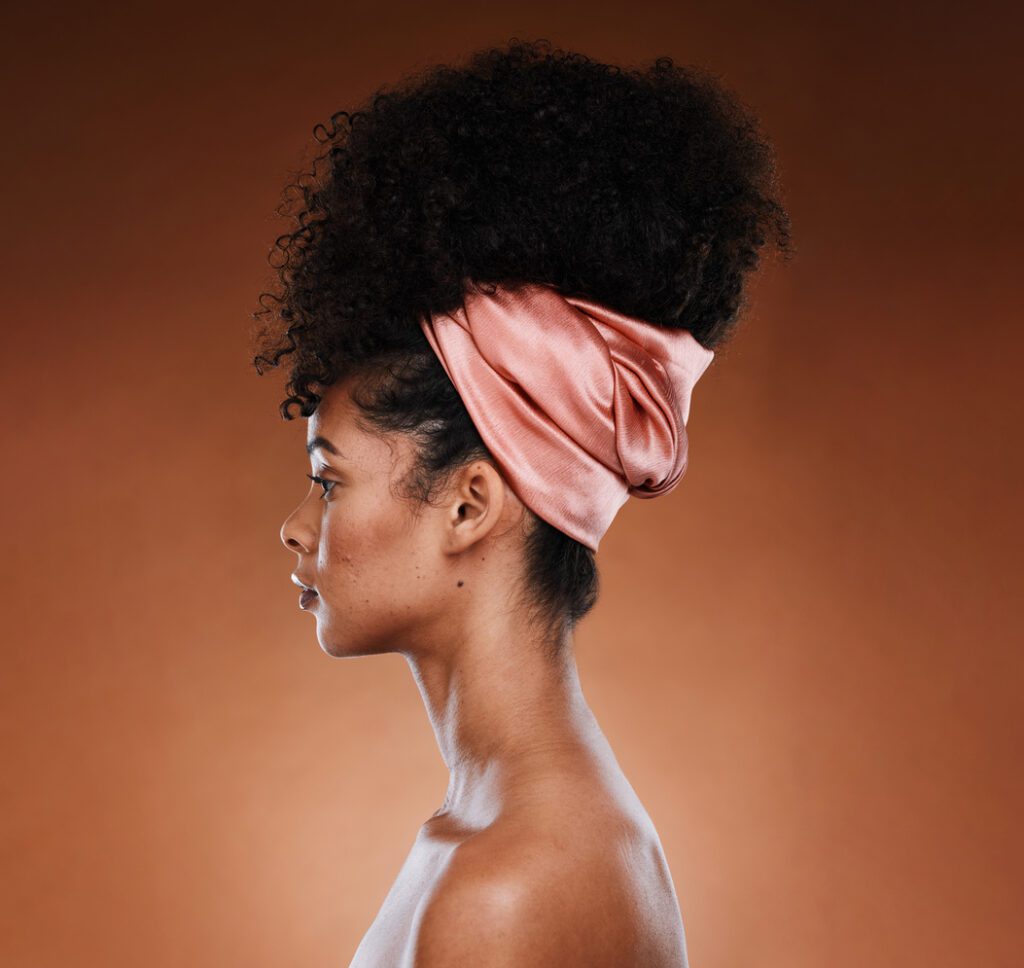
Caring for type 4 hair at night
- Moisturize your hair before bed: Prevent dryness by moisturizing your hair before bed, either with a spritz of water or a leave-in conditioner. Seal in the moisture with oil.
- Put your hair in a low-manipulation style overnight: To protect it, put it in a low-manipulation style overnight based on your hair length and hairstyle. If you’re rocking a twist out or braid out, re-braid/twist your hair before going to sleep. To preserve a stretched style, tie your hair in loose, chunky twists/braids or buns under a scarf.
- Sleep on a satin or silk pillowcase: Standard cotton or linen pillowcases wick moisture from your hair, causing it to dry out quickly, and can be rough on curls and coils, causing them to snag. Silk and satin absorb less moisture from your hair than cotton or linen.
- Stay hydrated: Drink plenty of water to keep yourself hydrated, which will help keep your skin and scalp healthy.
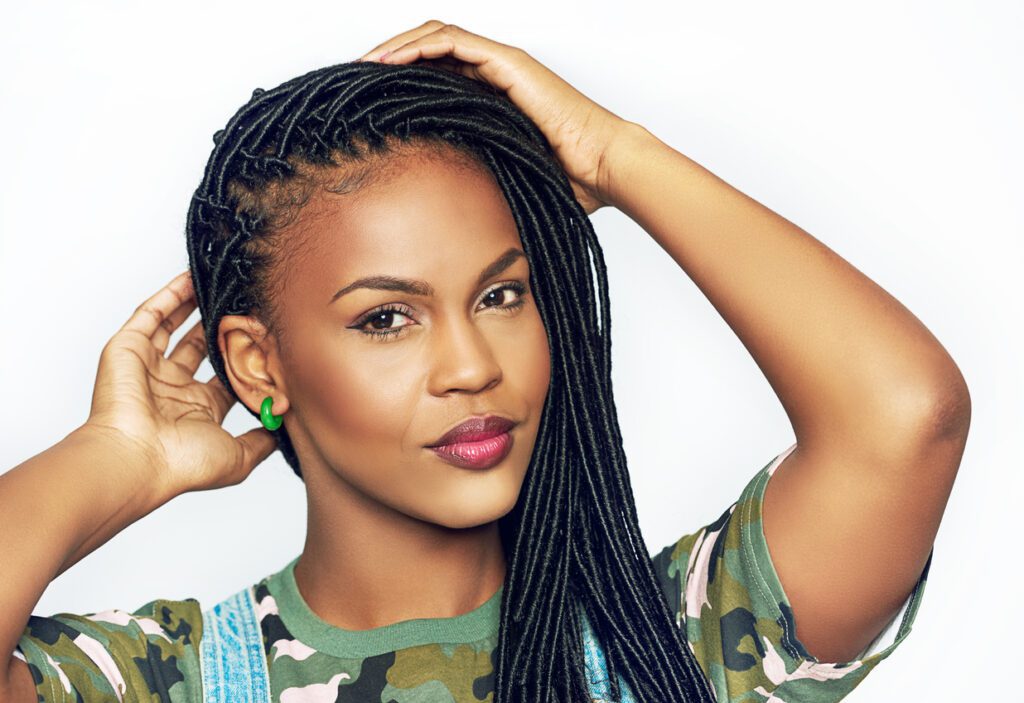
The Versatility of Type 4 Hair
Type 4 hair is the most coil-like and kinky of the four groups, which means it is most prone to shrinkage and frizz. Type 4 hair follows a Z-shaped curl pattern, but type 4C is more tightly coiled than type 4B.
Many hairstyles are perfect for type 4 hair. As long as they are not too tight, protective styles like cornrows, weaves, box braids, crochet braids, and Bantu knots lend your hair excellent protection and look highly stylish. Two-strand twists are another style that can be done with type 4 hair. Updos with scarves can also reduce styling time – pull your hair into a high ponytail towards the front of your head like bangs and wrap a scarf around the base while leaving your ponytail out.
Wash-and-go hairstyles are also popular for type 4 hair. It’s essential to find the right balance of products so that your hair doesn’t get weighed down. Regular deep conditioning can help achieve luminosity in wash-and-go hairstyles. Bantu knots are another popular hairstyle for type 4 hair – they can be left in for a few days or taken down for a wavy curl look.
The Beauty of Type 4 Hair
Type 4 hair has tight coils and can be fragile. At a glance, type 4 hair appears as a mass of tight curls brimming with vitality. Type 4 hair usually looks coarse but is often very fine, and the hair strands are generally thickly packed together.
Type 4 hair requires lots of moisture, nourishment, and a gentle hand on those beautiful coils. All type 4 hair types are prone to dryness. Due to the naturally defined curls and their moisture retention capacity, wash n’ go hairstyles look great on women with Type 4 hair. Taking care of this hair type is very important. Use sulfate-free shampoos to wash your hair that contain jojoba oil or tee tree oil. Other products that work well for this hair type include light butters and products that weigh down the strands to lengthen them subtly.
Remember that everyone’s hair is unique, so finding what works best for you may take trial and error.
For the best hair products for Type 4 hair, peruse our Ultimate Guides Collection. You get access to every guide when you join AEC, or you can purchase individual guides in the SHOP. When you join AEC, you also get access to our exclusive curly stylist Salon database.


